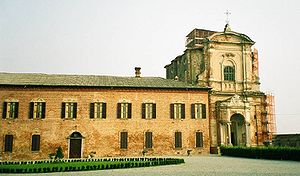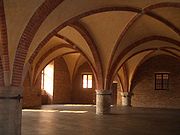
Lucedio Abbey
Encyclopedia

Trino
Trino is a comune in the Province of Vercelli in the Italian region Piedmont, located about 50 km northeast of Turin and about 15 km southwest of Vercelli, at the foot of the Montferrat hills....
, which is now in the province of Vercelli
Province of Vercelli
Vercelli is a province in the Piedmont region of northern Italy. Its capital is Vercelli., it has an area of 2,088 km², and a total population of 176,829...
, north-west Italy
Italy
Italy , officially the Italian Republic languages]] under the European Charter for Regional or Minority Languages. In each of these, Italy's official name is as follows:;;;;;;;;), is a unitary parliamentary republic in South-Central Europe. To the north it borders France, Switzerland, Austria and...
. It played an important role in the development of rice production in the region.
History
The abbeyAbbey
An abbey is a Catholic monastery or convent, under the authority of an Abbot or an Abbess, who serves as the spiritual father or mother of the community.The term can also refer to an establishment which has long ceased to function as an abbey,...
was founded in 1124, when Renier I of Montferrat
Renier I of Montferrat
Renier or Rainier was the ruler of the state of Montferrat in north-west Italy from about 1100 to his death, and the first such to be identified in contemporary documents as Margrave of Montferrat....
provided an
an extensive tract of marsh, heath and woodland known as Locez, on whose agricultural development the future prosperity of Lucedio would depend.
As the second daughter-house of La Ferté (after Tiglieto Abbey
Tiglieto Abbey
Tiglieto Abbey is a religious complex in Tiglieto, Liguria, northern Italy...
, in the Ligurian Apennines), this was one of the earliest Cistercian monasteries in Italy. Lucedio contributed in its turn to the expansion of the Cistercian Order by giving birth to three daughter-houses over the next eighty years: S. Maria di Chiaravalle
Chiaravalle
Chiaravalle may refer to:* Chiaravalle , a district of Milan, Italy* Chiaravalle Abbey: Cistercian abbey in the eponymous district of Milan* Chiaravalle , a town in the province of Ancona...
della Castagnola (1147) in the Marche
Marche
The population density in the region is below the national average. In 2008, it was 161.5 inhabitants per km2, compared to the national figure of 198.8. It is highest in the province of Ancona , and lowest in the province of Macerata...
, Rivalta Scrivia (1180) near Tortona
Tortona
Tortona is a comune of Piemonte, in the Province of Alessandria, Italy. Tortona is sited on the right bank of the Scrivia between the plain of Marengo and the foothills of the Ligurian Apennines.-History:...
and Acqualunga (1204) near Pavia
Pavia
Pavia , the ancient Ticinum, is a town and comune of south-western Lombardy, northern Italy, 35 km south of Milan on the lower Ticino river near its confluence with the Po. It is the capital of the province of Pavia. It has a population of c. 71,000...
.

Boniface of Montferrat
Boniface of Montferrat was Marquess of Montferrat and the leader of the Fourth Crusade. He was the third son of William V of Montferrat and Judith of Babenberg, born after his father's return from the Second Crusade...
, grandson of Renier, on the notorious Fourth Crusade
Fourth Crusade
The Fourth Crusade was originally intended to conquer Muslim-controlled Jerusalem by means of an invasion through Egypt. Instead, in April 1204, the Crusaders of Western Europe invaded and conquered the Christian city of Constantinople, capital of the Eastern Roman Empire...
.
After the sack of Constantinople
Fourth Crusade
The Fourth Crusade was originally intended to conquer Muslim-controlled Jerusalem by means of an invasion through Egypt. Instead, in April 1204, the Crusaders of Western Europe invaded and conquered the Christian city of Constantinople, capital of the Eastern Roman Empire...
in 1204 Boniface, as leader of the crusade, had expectations of being appointed the first
emperor of the new Latin Empire
Latin Empire
The Latin Empire or Latin Empire of Constantinople is the name given by historians to the feudal Crusader state founded by the leaders of the Fourth Crusade on lands captured from the Byzantine Empire. It was established after the capture of Constantinople in 1204 and lasted until 1261...
. Abbot Peter was among the electors and is presumed to have been among the two or three who voted for Boniface. The crown, however, went to Baldwin
Baldwin I of Constantinople
Baldwin I , the first emperor of the Latin Empire of Constantinople, as Baldwin IX Count of Flanders and as Baldwin VI Count of Hainaut, was one of the most prominent leaders of the Fourth Crusade, which resulted in the capture of Constantinople, the conquest of the greater part of the Byzantine...
, Count of Flanders
Count of Flanders
The Count of Flanders was the ruler or sub-ruler of the county of Flanders from the 9th century until the abolition of the position by the French revolutionaries in 1790....
who had the support of the Venetians
Republic of Venice
The Republic of Venice or Venetian Republic was a state originating from the city of Venice in Northeastern Italy. It existed for over a millennium, from the late 7th century until 1797. It was formally known as the Most Serene Republic of Venice and is often referred to as La Serenissima, in...
.
Thwarted in this ambition, Boniface and his crusaders conquered Thessalonica and was installed by Baldwin as king of the Crusader state the Kingdom of Thessalonica
Kingdom of Thessalonica
The Kingdom of Thessalonica was a short-lived Crusader State founded after the Fourth Crusade over the conquered Byzantine lands.- Background :...
, albeit under authority of Constantinople. Peter became Bishop of Ivrea (and later Patriarch of Antioch) and his long-time associate Ogliero (who was later beatified
Beatification
Beatification is a recognition accorded by the Catholic Church of a dead person's entrance into Heaven and capacity to intercede on behalf of individuals who pray in his or her name . Beatification is the third of the four steps in the canonization process...
by the Church) took his place as Abbot of Lucedio in 1205. The abbey then housed fifty monks.
In 1214 two further daughter-houses of Lucedio were founded in the Crusader states:
Saint George de Jubino in the Principality of Antioch
Principality of Antioch
The Principality of Antioch, including parts of modern-day Turkey and Syria, was one of the crusader states created during the First Crusade.-Foundation:...
and
Chortaïton in Thessalonica.
The abbey managed its agricultural assets employing the grange system and was effective in developing the productivity of the land, notably introducing the cultivation of rice to this damp riverside area in the fifteenth century. Today the Vercelli region is one of the most important areas of rice production in Italy.
From 1457, by an act of Pope Callixtus III, Lucedio was placed under commendatorial control
In Commendam
In canon law, commendam was a form of transferring an ecclesiastical benefice in trust to the custody of a patron...
, losing prestige and autonomy.
The abbey was secularized in 1784, the remaining monks being transferred to a Jesuit college in Castelnuovo Scrivia
Castelnuovo Scrivia
Castelnuovo Scrivia is a comune in the Province of Alessandria in the Italian region Piedmont, located about 90 km east of Turin and about 20 km northeast of Alessandria.-History:...
. The buildings and their lands have passed through various hands in subsequent years, including those of Napoleon Bonaparte, who gave it to Camillo Borghese
Borghese
Borghese is the surname of a family of Italian noble and papal background, originating as the Borghese or Borghesi in Siena, where they came to prominence in the 13th century holding offices under the commune. The head of the family, Marcantonio, moved to Rome in the 16th century and there,...
in exchange for a large quantity of artworks which are now housed in the Louvre
Louvre
The Musée du Louvre – in English, the Louvre Museum or simply the Louvre – is one of the world's largest museums, the most visited art museum in the world and a historic monument. A central landmark of Paris, it is located on the Right Bank of the Seine in the 1st arrondissement...
. Today the abbey buildings are incorporated into a rice farm.
Architecture
The church — which became a parish church after the closure of the abbey — was extensively remodelled in the eighteenth century. Its striking medieval bell-tower however remains intact: a rectangular base from 1150–1175 supporting an octagonal structure from perhaps a hundred years later. It is currently undergoing extensive restoration work.External links
External links
(Basic data on Lucedio.)} (History of Lucedio. In Italian.)
} (Architecture of Lucedio. In Italian.)

